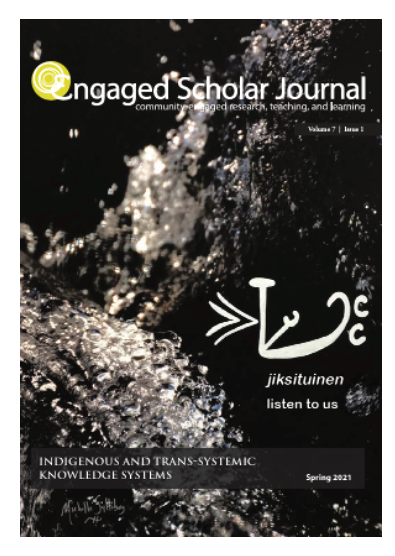wahkotowin: Reconnecting to the Spirit of nêhiyawêwin (Cree Language)
DOI:
https://doi.org/10.15402/esj.v7i1.69979Keywords:
nêhiyawêwin, decolonization, land-based, ceremony, kinshipAbstract
The Spirit of the Language project looks to the Spirit of nêhiyawêwin (Cree language), sources of disconnection between nêhiyawak (Cree people) in Treaty 6 and the Spirit of nêhiyawêwin, and the process of reconnection to the Spirit of the language as voiced by nêhiyawak. The two researchers behind this project are nêhiyaw language-learners who identify as insider-outsiders in this work. The work is founded in Indigenous Research Methodologies, with a particular respect to ceremony, community protocol, consent, and community participation, respect and reciprocity. We identified the Spirit of the language as having three distinct strands: history, harms, and healing. The Spirit of Indigenous languages is dependent on its history of land, languages, and laws. We then identified the harms or catalysts of disconnect from the Spirit of the language as colonization, capitalism, and Christianity. The results of our community work have identified the methods for healing, or reconnecting to the Spirit of language, by way of autonomy, authority, and agency.
References
Auger, Darlene. Edmonton, Alberta, personal communication, October 19, 2019.
Barnhardt, R., & Kawagley, A. O. (2008). Indigenous knowledge systems and education. Yearbook for
the National Society for the Study of Education, 107(1), 223-241.
Blackstock, C., Trocm , N., & Bennett, M. (2004). Child maltreatment investigations among
Aboriginal and non-Aboriginal families in Canada. Violence Against Women, 10(8), 901–916.
https://doi.org/10.1177/1077801204266312
Cannon, M. (2012). Changing the subject in teacher education: Centering Indigenous, diasporic
and settler colonial relations. Cultural and Pedagogical Inquiry, 4(1), 21-36. https://journals.
library.ualberta.ca/cpi/index.php/cpi/article/view/19109
Corntassel, J. (2013). Insurgent education and the roles of Indigenous intellectuals. In M. Smith (Ed.), Transforming the academy: Essays on Indigenous education, knowledges, and relationship (pp. 47-51). Edmonton, AB: University of Alberta. https://www.academia.edu/12915050/E_Book_Transforming_the_Academy_Essays_on_Indigenous_Education_Knowledges_and_Relations
Coulthard, G. (2014). Red skin, white masks: Rejecting the colonial politics of recognition. University of
Minnesota Press.
Curtis, G. (1915, October). Early conversions to the Catholic Church in America (1521-1830). The
Catholic Historical Review, 1(3), 271-281. https://www.jstor.org/stable/25011337
Donald, D. T. (2009). Forts, curriculum, and Indigenous m tissage: Imagining decolonization of
Aboriginal-Canadian relations in educational contexts. First Nations Perspectives: The Journal
of the Manitoba First Nations Education Resource Centre, 2(1), 1-24. https://www.academia.
edu/12915050/E_Book_Transforming_the_Academy_Essays_on_Indigenous_Education_
Knowledges_and_Relations
Donald, D. (2013). On making love to death: Plains Cree and Blackfoot wisdom. In M. Smith (Ed.),
Transforming the academy: Essays on Indigenous education, knowledges, and relationship (pp. 14-
. https://www.academia.edu/12915050/E_Book_Transforming_the_Academy_Essays_
on_Indigenous_Education_Knowledges_and_Relations
Greymorning, N. (2018, November, 29). Being Indigenous: Perspectives on activism, culture, language
and identity. Routledge.
Hopwood, V. G. (Ed.). (1971). David Thompson’s travels in Western North America, 1784-1812.
Macmillan.
Kovach, M. (2009). Indigenous methodologies: Characteristics, conversations, and contexts, University of
Toronto Press.
Lacombe, A. (1874). Dictionnaire de la langue des Cris. C. O. Beauchemin & Valois.
https://archive.org/details/cihm_30679/page/n14
Leavitt, K. (2018, August 2). Racing against time to bring Indigenous language back from the brink.
The Star. https://www.thestar.com/edmonton/2018/08/02/will-the-governments-indigenouslanguages-
law-save-endangered-tongues.html
Lee, D., & King, G. (2020, March 2). Re-affirming Indigenous citizenships: Two Spirit familymaking
and the future of belonging. Yellowhead Institute.
https://yellowheadinstitute.org/2020/03/04/re-affirming-indigenous-citizenships/
Legacy of Hope. (2015, December). Indian Residential School System Timeline (image). Legacy of
Hope Foundation.
Makokis, L., Shirt, M., Chisan, S., Mageau, A., & Steinhauer, D. (2010). m mawi-nehiyaw
iyinikahiwewin. Blue Quills First Nation College. http://www.bluequills.ca/wp-content/
uploads/2017/03/BQ_SSHRC_2010_final_report.pdf
Milloy, J. S. (1990). The Plains Cree: Trade, diplomacy and war, 1790 to 1870. University of Manitoba
Press. https://www.deslibris.ca/ID/412998
Murdoch, J. (1981). A serious read on syllabics: The M.Ed thesis of John Murdoch. Cree Literacy
Network. https://creeliteracy.org/beginning-to-read-plains-cree-in-standard-romanorthography/
a-serious-read-on-syllabics-the-m-ed-thesis-of-john-murdoch/
Preston, R. (2018). Cree. In The Canadian Encyclopedia. Retrieved July 12, 2019, from https://www.
thecanadianencyclopedia.ca/en/article/cree
Statistics Canada. (2017, October 25). Census in brief: The Aboriginal languages of First Nations People,
M tis and Inuit. Statistics Canada. https://www12.statcan.gc.ca/census-recensement/2016/assa/
-200-x/2016022/98-200-x2016022-eng.cfm
Smith, L. T. (2012). Decolonizing methodologies: Research and Indigenous Peoples. Zed Books.
Truth and Reconciliation. (2015). Honouring the Truth, Reconciling for the Future: Summary of the
Final Report of the Truth and Reconciliation Commission of Canada. Government of Canada.
Wilson, S. (2001). What is indigenous research methodology? Canadian Journal of Native Education,
(20), 175-179. https://www.researchgate.net/publication/234754037_What_Is_an_
Indigenous_Research_Methodology
Wilson, S. (2008). Research is ceremony: Indigenous research methods. Fernwood Publishing.
Published
How to Cite
Issue
Section
License
Authors who publish with this journal agree to the following terms:
- Authors retain copyright and grant the journal right of first publication with the work simultaneously licensed under a Creative Commons Attribution License CC BY 4.0 that allows others to share the work with an acknowledgement of the work's authorship and initial publication in this journal.
- Authors are able to enter separate, additional contractual agreements for the non-exclusive distribution of the journal's published version of the work (e.g., post it to an institutional repository or publish it in a book), with an acknowledgement of its initial publication in this journal.
- Authors are permitted to post their work online (e.g., in an institutional repository or on their website) after the publication of their work in the Engaged Scholar Journal.
- Please note that while every opportunity will be taken to ensure author participation in the editing process, due to time constraints final copyediting changes may be made before publication to ensure APA adherence throughout all submissions.




